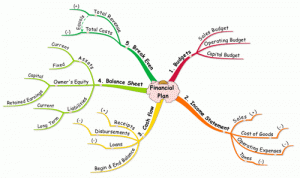 If financial planning is a cumbersome exercise, here are six (6) steps you can take to make the process a more fun & engaging experience:
If financial planning is a cumbersome exercise, here are six (6) steps you can take to make the process a more fun & engaging experience:
1. Schedule time to plan >> Really. One of the biggest challenges to planning (financial or otherwise) is setting aside a block of time to do it. Accordingly, don’t operate with the expectation that you will complete your plan in one sitting. A better approach is to give yourself thirty-days to create your plan, and within that period of time complete the next five steps.
2. Have a brainstorming session (or two, three) >> During this time, simply have an uncensored brain dump of your goals. Rather than listing your goals using a vertical approach, try documenting your goals using an approach called mind mapping. I love mind mapping because I believe it is a more expansive way to think about what you want to have, do and be. The picture above is an example.
Place your name in the center and note all of your goals as extensions or spokes from the middle. IMPORTANT: Don’t worry just yet about categorizing them as financial vs. non-financial or ranking them by time (short, medium, or long-term) or identifying the goals that are connected. That happens next! For now, just think and write!!
3. Create a to-do list of habits >> For each goal listed in step #2, specify details such as the financial component, if any; your target “Achieve By” date; the dependent relationship that may exist between goals; and what habit you will need to consistently do and how often in order to contribute to the manifestation of each goal. (Breaking your goal down to a habit is a gem, and it was first introduced to me by Alexia Vernon of Catalyst for Action and AwakenYourCareerpreneur.com )
A good tool to use for this step is an excel spreadsheet; here’s a template I created for myself.
4. Identify your three by three >> Review your goals along with the details you’ve written for each. From this list, choose three that will be your priority for the next three months. You can choose by whatever factor/s makes the most sense for you, i.e., financial component, time to achievement, or what is required of you to make it happen. NOTE: The three goals you choose do not need to have a target “Achieve By” date that is within the next three months; they are simply the goals you want to put the most energy towards for the next three months.
5. R.M.A.Re4 >> This stands for review, monitor, adjust, and select the next three. For maximum results, it is best to check-in with yourself weekly, this will help you monitor the progress you’re making and to ascertain what, if any, adjustments are necessary. Then, repeat step #4 – select the next three goals on which you want to focus.
6. Celebrate >> At the end of each three month cycle, do something to celebrate the milestones you’ve accomplished, as well as the progress you’ve made towards the goals that remain a work-in-progress. You must bless the process as well as the end-result!




